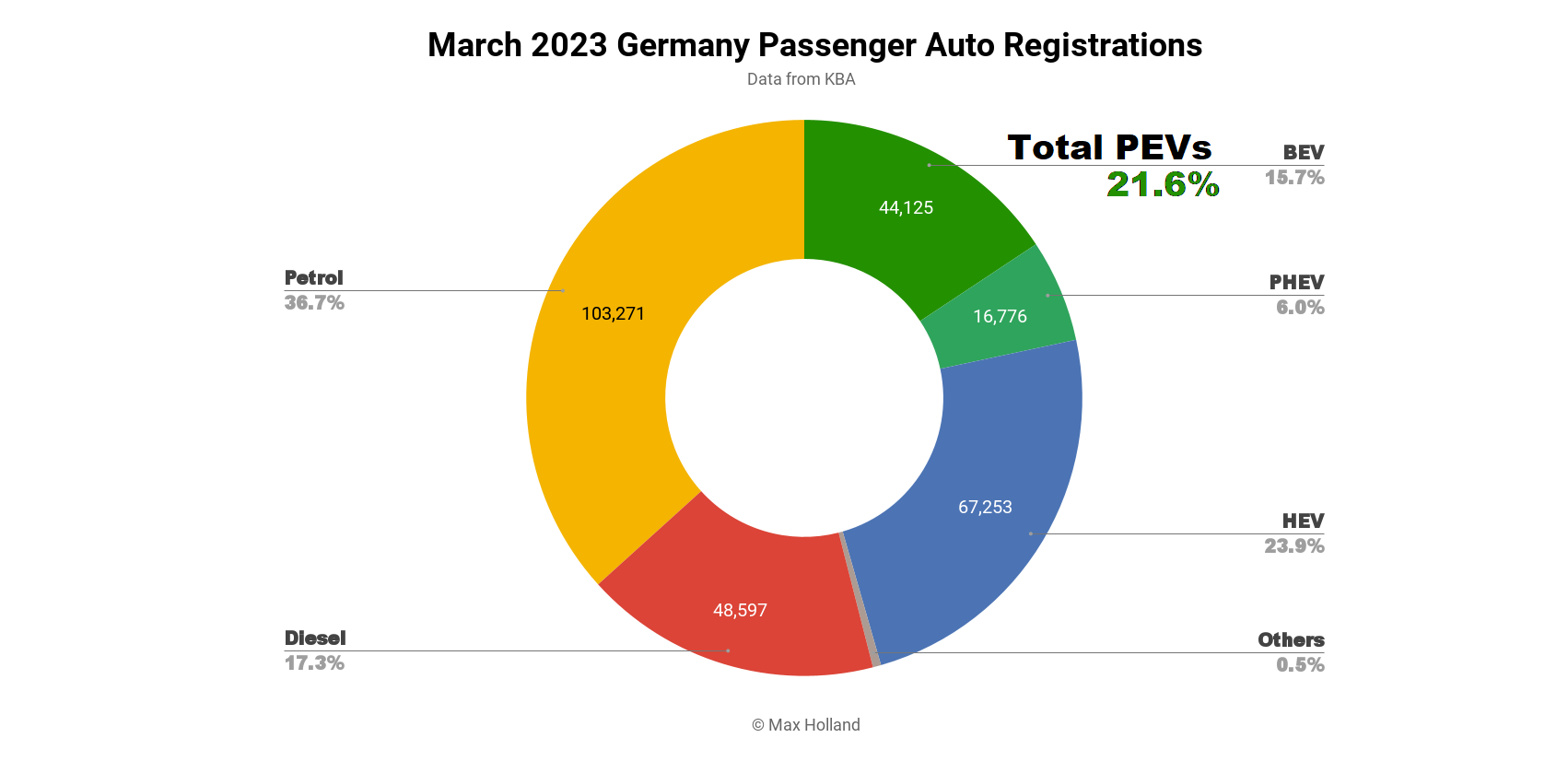Germany — Tesla Model Y Leads In Hangover Plugin Market
Germany’s plugin electric vehicles took 21.6% of the auto market in March, down from 25.6% year on year. BEV grew share slightly, but PHEVs lost half their share YoY, due to recent policy changes. Overall auto volume was 281,361 units, up over 16% YoY, but still well down from pre-2020 seasonal norms.
March’s combined plugin share of 21.6% comprised 15.7% full electrics (BEVs), and 6.0% plugin hybrids (PHEVs). These shares compare with corresponding YoY figures of 25.6%, 14.3%, and 11.3%.
Recall that we are still in the hangover phase of the significant plugin incentive cuts that came in on January 1st (see reports from December and January for more detail). Despite this, in volume terms, BEVs saw decent YoY growth, slightly ahead of the overall market, growing sales 28% to 44,125 units. This was close to the 3rd highest volume ever (trailing the past two Decembers).
PHEVs — which lost the entire Umweltbonus incentive from January 1st — saw sales hit harder, thus the almost halving of share YoY. Their volume was down some 38% YoY, to 16,776 units.
Diesel share continued its steady decline, but petrol share actually rose YoY, from 34.9% to 36.7%. Obviously this growth in petrol share is temporary, related to the plugin incentive hangover and a resettling of the market.
As we also saw in the UK market, plugless hybrids are doing well in Germany — essentially converting sales of combustion-only vehicles over to this marginally improved technology. They are only a temporary waypoint on the road to full electric vehicles.
Best Selling BEVs
With local Brandenburg production now ramping past 22,000 units per month, the Tesla Model Y was yet again the bestselling BEV in March. In second place was the Volkswagen ID.4/5, and in third was the ID.3.
Few of the top 20 BEVs turned up in particularly outstanding volumes, compared to their own previous averages. Only the MG4 put in a personal best performance, with 1,389 units delivered, near to twice its previous high (February).
There were a few newcomer BEV models visible further down the sales charts. The Smart “#1”, having first delivered in noticeable volume in December, had personal-best deliveries of 313 units in March.
The Ora Funky Cat saw its first volume month, with 162 units. Nio brand delivered 121 units across all models in March (up from just 13 units previously), mostly the ET5 and EL7, and a few ET7. It will be interesting to see if Nio can compete against the Germany premium brands in their home market.
Finally, Opel registered the first 42 units of the new Astra in Germany. It’s not yet clear if these are dealer demonstration units, or whether they are in fact end-customer deliveries. Either way, the doors have opened, and it is good to see Stellantis’ next generation platform — supporting both hatchback and touring body styles — now hitting the streets in Europe.
Now let’s look back at the trailing 3 month performances, bearing in mind that the market is still unsettled following the recent incentive changes:
The Tesla Model Y overwhelms all others, with volume close to the next 3 BEVs combined (including its own sibling, the Model 3). With local production continuing to grow, it is hard to see the Model Y’s dominance diminishing anytime soon.
The Model Y now starts at just under €45,000 in Germany, before incentives, so continues to remain attractive despite the recent trimming of the government bonus. Most other BEVs in the top 20 (except the MG4, and BMW iX1) have lost significant volume since Q4 2022 (before the incentive trim). The Model Y has increased delivery volume by 20% over the period, and gapped all its nearest rivals.
Since we are still in the unsettled and unrepresentative BEV market conditions, following the recent incentive changes, I’m not going to analyse the movements in ranking since Q4 in any greater detail. Suffice it to say that the Model Y, MG4 and BMW iX1 are all climbing the ranks, whilst others just tread water until the market resettles.
Outlook
The auto market’s YoY growth in March, which the KBA attributes to improving supply chain constraints, was a welcome talking point for the broader German economy. It is now forecast that the economy may be able to avoid recession through 2023, and instead may see fractional growth (0.2% to 0.3%, depending who you ask).
Inflation remains high but softening (7.4% from 8.7% recently), much of it due to increased energy and food prices. Plugin vehicle owners who have access to cheap overnight electricity rates are still seeing good savings on total cost of ownership compared to combustion vehicles. This being the case, and with model diversity and infrastructure density improving, we can expect demand for plugins to remain high relative to plugless vehicles, in the medium term.
In the short term, however, the disjuncture from the January 1st incentive changes has not yet settled, and we should expect modest growth for plugins until sometime in the summer when the trends will stabilise.
What are your thoughts on Germany’s EV transition? Please jump into the discussion below.
Have a tip for CleanTechnica? Want to advertise? Want to suggest a guest for our CleanTech Talk podcast? Contact us here.
Sign up for our daily newsletter for 15 new cleantech stories a day. Or sign up for our weekly one if daily is too frequent.
CleanTechnica's Comment Policy
